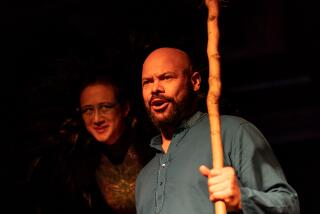A Midsummer Day’s Dream in Shakespeareland
- Share via
STRATFORD-ON-AVON, England — Nothing makes the blood burn and the mind whirl quite like William Shakespeare’s birthplace.
A visit here is not just another tour stop. Imagine: The very house where Shakespeare lived. The actual room where he was born.
Without question, this is the literary world’s greatest attraction. About a million people each year experience the magic and power of this shrine.
The whitewashed Tudor house with its dark timbers and steep roofs dominates Henley Street the way the man who lived here looms over the English language.
For the worshiper of poetry and drama, this is Mecca. The back yard garden is holy ground. The house is a temple. It is difficult not to think in those terms.
Only the hardest heart can approach the birthplace without some feeling of wonder. It may not be the biggest or fanciest house in Sratford, but it is the only one that people travel halfway around the world to see and to touch. In this setting Shakespeare, the distant icon, becomes Shakespeare the human being: I picture him as a dreamy youth warming his back by the big stone fireplace while snippets of sonnets drift through his head.
But, soft! There is more.
Roam about the town and you can see where Shakespeare--the man John Milton called “fancy’s child” and John Dryden hailed as “divine”--went to school, hiked to court his wife, attended plays, drank, retired and was buried.
And if that isn’t enough Shakespeare, businesses all over town bear his name or the names of his characters, and his face is on T-shirts, posters, mugs, books and even spoon handles.
Everywhere it’s Shakespeare, Shakespeare. Bardolatry is big business.
Ninety-three miles from London and 40 miles from Oxford, Stratford is an easy journey through rolling hills and green pastures that constitute some of the loveliest farmscapes in England.
But when you get here, the town has so many half-timbered buildings that it looks fake, like the set for an Elizabethan movie. Oddly enough, Stratford, second only to London as England’s top tourist attraction, wasn’t always so picturesque--not even in Shakespeare’s day.
In fact, if Shakespeare were to drop in today, he might have difficulty recognizing not only the town but his own house. When he was there, it was two houses, bought at separate dates and later joined in the middle to form what is now an imposing, three-gabled house.
The birthplace has had many occupants over the centuries. Apparently it was handed down from generation to generation in the Shakespeare family until the 19th Century when it was sold and turned into a butcher shop. It was eventually bought on behalf of the nation in 1847 as a public trust.
Even with such a plumb attraction, Shakespeare remained essentially a cottage industry for decades. Astoundingly, 263 years had elapsed after the poet’s death before Stratford mayor Charles Edward Flower awakened his neighbors to the gold mine at hand. Among Flower’s accomplishments: In 1879 he established the Shakespeare Memorial Foundation, which gave Stratford its theater.
Ever the promoter, Flower convinced his constituents to strip the boards and plaster from the exteriors of businesses and homes to get down to the basics of Tudor style--a ploy that transformed Stratford into a sort of 16th-Century theme park: a Shakespeareland, of sorts.
As new buildings went up, many adopted an ancient look. Today it is hard to tell the new from the old. But who cares? One of the pleasures of visiting Stratford is pretending how things might have been.
Yet stepping back into history here is not without its annoyances.
The approach to the house is from the front, along noisy, pedestrian-clogged Henley Street, with its shops hawking souvenirs of double-decker buses, London policemen and, of course, the Bard himself. Having survived that assault, the senses are tossed for a loop by the entrance to the grounds, which are graced by an incongruously austere and modern visitors center.
From there, walk through the meticulously groomed garden, a place of uncommon delight and beauty but where meditation competes with the roar of traffic pounding along Birmingham Road on the other side of the garden wall.
Next, duck under a low doorway and go into the house. Wander through the rooms until you finally reach the upstairs room where Shakespeare was born. Because the room has doors at both ends, it is, in reality, a hallway, which may help in keeping the traffic flowing but does nothing to enhance its charm. These are sterile digs.
It is here, a guide likes to point out, that long-ago visitors carved their names on the windows and plaster walls. Still to be seen are the engravings of Sir Walter Scott, Alfred Tennyson, Charles Dickens and Edmund Kean.
But don’t expect to see much of the defacements or anything else of interest in this room. What you get instead is a view of fannies and shoulders, shoes and hairdos. In the scramble of tourists shuffling past, unencumbered vistas of the room are as rare as Shakespeare’s autograph.
But that is the danger of Shakespeareland in tourist season, whose peak months are July and August. If you want to linger to soak in the atmosphere, good luck. Chances are, you will become a pebble in a human stream that jostles and nudges you out the door.
An overcast day is best for visiting the birthplace. Gloomy weather, when the sky is close and the air is damp, prompts a contemplative mood, which in turn evokes dark thoughts about this house.
For starters, this is not technically Shakespeare’s house. When he lived here, it was his father’s house. Sure, Shakespeare probably was born here, maybe even in the upstairs bedroom, but that can’t be proved. Neither can the exact day he was born. In fact, so much about Shakespeare is guesswork (including how he spelled his name, which is variously referred to as Shaksper, Shakspere, Shaxpere, Shackespere, Shaxpeare, Shackspeare, Shexpere, Shake-spear and Shakespeares) that the more you know about him, the more you wonder.
About all we know for certain is what we find on the parish register of Holy Trinity Church in Stratford. It states that on April 26, 1564, a William Shakespeare (actually, “Gulielmus filius Johannes Shakspere”) was christened in the church. Since christening usually occurred within a few days of birth, the birthday has generally been assumed to be April 23. This provides a sweet symmetry to Shakespeare’s life, for he died on this same date 52 years later.
Exactly where Shakespeare was born is a matter of conjecture, too. Since home births were the rule in those days, and since Shakespeare’s parents owned the house on Henley Street at that time, it seems logical to assume he was born there.
In other words, tradition is the tangled web in which Stratford entangles literary tourists.
What do we know about Shakespeare’s years at the house on Henley Street? About as much as we do about his entire life history: Not much. Why is it all so vague? Perhaps because, as Mark Twain claimed, “He hadn’t any history to record.”
Well, that’s not totally accurate.
Town documents show that his father was John Shakespeare, a glover and leather-dresser and a dealer in wool and farm produce who first appeared in Stratford in 1552, when he was fined for having a dunghill in front of his house. The next 25 years were good for him, though. He prospered and bought two houses on Henley Street in 1556 and two others during the next 20 years. By 1568, he had risen from chamberlain to burgess to alderman and bailiff.
But something went amiss. From 1577 until his death in 1601 he fell on hard times. He stopped attending town council meetings and avoided the church.
William Shakespeare was the first son and third child in a family of eight children born to John Shakespeare and his wife, Mary Arden Shakespeare. He apparently attended school in the classroom adjacent to the Guild Chapel of the Holy Cross. When young Will was growing up, Stratford was a bustling country village of 1,500 living in 215 houses.
After his birth, Shakespeare is next documented when he was 18 and married 26-year-old Anne Hathaway--a marriage with a scandalous undertone. He took out a license to marry Anne Whatley of Temple Grafton on Nov. 27, 1582, but the next day a bond was given naming the bride as Anne Hathwey of Stratford. Six months later, on May 26, 1583, their first child, Susanna, was baptized. It is not hard to picture Anne Hathaway’s father, learning of the impending marriage, prompting a shotgun wedding for his daughter. Anyway, twins were baptized on Feb. 2, 1585, as Judith and Hamnet.
Following the baptism of the twins, Shakespeare is harder to trace. The next contemporary reference to his whereabouts comes seven years later and infers that he had become well established in the London theater scene. How he accomplished that isn’t clear. Nor is it known why he turned to writing plays, why he left his family behind in Stratford, how he earned his way or what others thought of him.
Think on this: Shakespeare somehow managed to live for more than a half-century and to be celebrated for writing plays that defined the human race while leaving hardly a trace as a person. No letters. One court deposition. Two stiff dedicatory notes. A handful of passing references by other people. Several business transactions. And, of course, the sonnets and the plays, which certainly reveal something about his personality but aren’t solid evidence of his life’s adventures.
Shakespeare was in London in the late 1590s and sometime in 1603 and 1604 was apparently a shareholder in the Globe and Blackfriars theaters. He also was reputed to have been an actor.
Then, for some unfathomable reason, at the height of his creative powers, Shakespeare abruptly stopped writing, quit London, retired to Stratford to New Place, the town’s second-largest house (which he had bought in May, 1597) and spent the last years of his life in obscurity.
Makes you wonder, doesn’t it?
About 350 years of intense and massive research into Shakespeare has yielded more questions than results. Is the man who grew up on Henley Street the same one able to send the English language soaring to incredible heights? Or was “Shakespeare” a pseudonym that just happened to be the same as the Stratford man’s name? If so, who wrote the plays? Was it Sir Francis Bacon? Christopher Marlowe? William Stanley, Earl of Derby? Edward de Vere, Earl of Oxford? Somebody else? Where? When? How? Why?
All this makes the birthplace truly a house of mystery.
As I stand in the birth room on a drizzly afternoon, my nerves are on edge; my guard is up. There is something vexing, something ominous, something indefinably wrong about this house. The pieces don’t add up:
Shakespeare is missing.
If Shakespeare exists in this house it is because the visitor imagines him here, certainly not because of any help on Shakespeare’s part. Over the centuries, virtually everything belonging to the Bard has disappeared.
It makes you think.
More to Read
Sign up for The Wild
We’ll help you find the best places to hike, bike and run, as well as the perfect silent spots for meditation and yoga.
You may occasionally receive promotional content from the Los Angeles Times.






